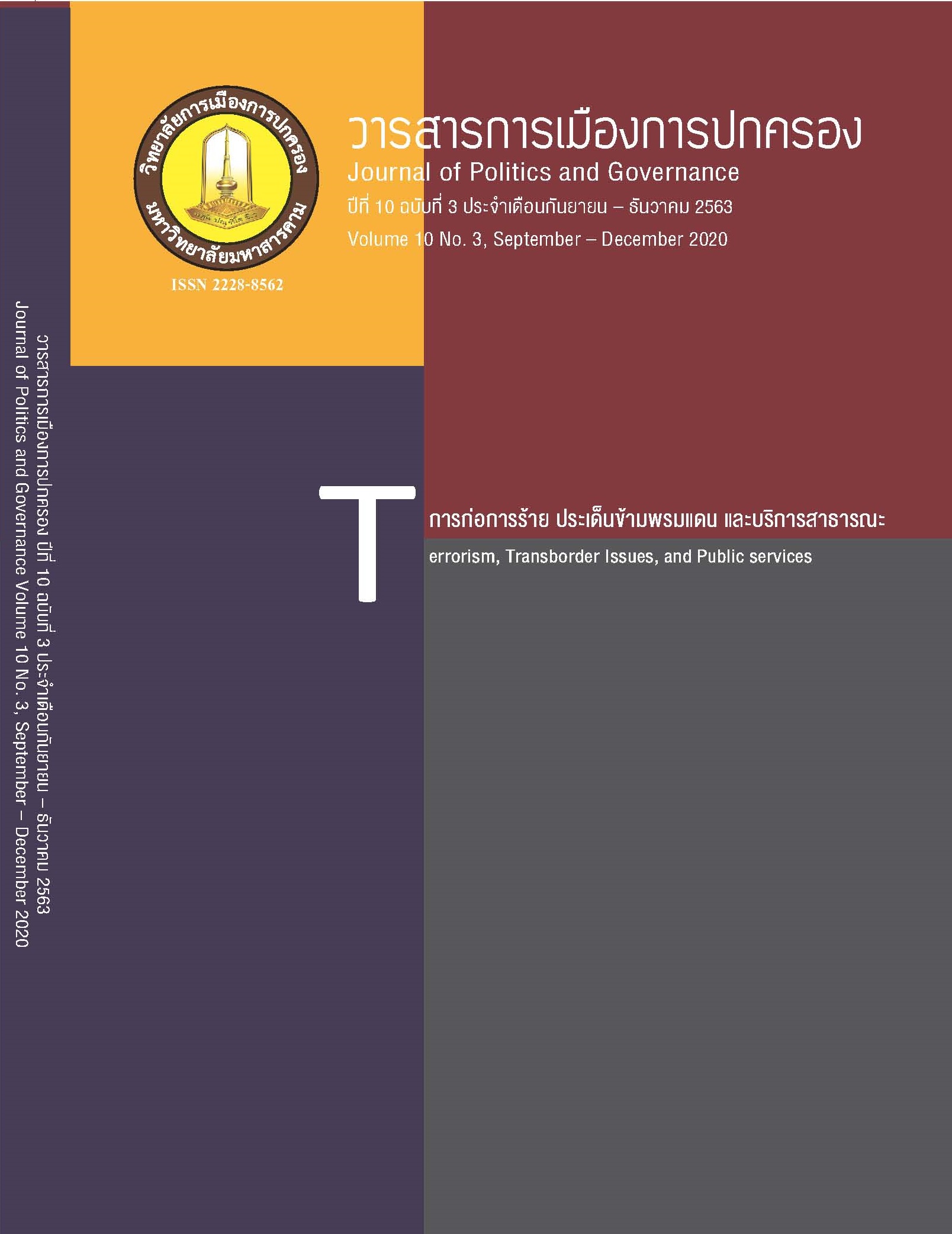Contemporary Urban Terrorism: Attack and Defense
Main Article Content
Abstract
This article aims to present the new phenomenon of violence in the 21st century as terrorism in the urban area or urban terrorism is the key issue. Terrorism in contemporary period differs from rural insurgency, which was the pattern of violence since the mid-20th century. Rural insurgency was characterized by locations of operations or targets. To put it another way, the geographical aspect of rural insurgency was remote from crowded community. However, at present days terrorist violence occurs mainly in urban area. This article will point out 3 main issues. First, urban terrorism demonstrates new pattern of contemporary violence, which are car bomb, human or suicide bomb, and lone-actor or lone wolf terrorism. Second, the changing pattern results from the development of new weapon/device: the development of explosive devices and technical know-how. Finally, the recommendations to handle and counter such violence rely on the concept of new environmental and building design
Article Details
References
Ashworth, G. J. (1991). War and the city. New York: Routledge.
Beall, J. (2007). Cities, terrorism and urban wars of the 21st century. Working Paper no. 9. London: Crisis States Research Centre.
Begin, M. (1977). The revolt: Story of the Irgun. (S. Katz, trans.) Jerusalem: Steimatzky's Agency.
Bowman, S. (2001). When the eagle screams: America's vulnerability to terrorism. San Jose: Writers Club Press.
CNN Editorial Research. (2019). Beirut marine barracks bombing fast facts. Retrieved from https://edition.cnn.com/2013/06/13/world/meast/beirut-marine-barracks-bombing-fast-facts/index.html
Coaffee, J. (2009). Terrorism, risk and the global city: Towards urban resilience. New York: Routledge.
Davis, M. (2007). Buda's wagon: A brief history of the car bomb. London: Verso.
Ervin, C. K. (2006). Open target: Where America is vulnerable to attack. New York: St. Martin’s Press.
Glaeser, E. L. & Shapiro, J. M. (2001). Cities and warfare: The impact of terrorism on urban form. Discussion Paper Number 1942. Retrieved from https://www.brown.edu/Research/Shapiro/pdfs/HIER1942.pdf
Graham, S. (Ed.). (2004). Cities, war, and terrorism: Towards an urban geopolitics. Malden, MA: Blackwell.
Graham, S. (2011). Cities under siege: The new military urbanism. New York: Verso.
Grossman, N. (2018). Drones and terrorism: Asymmetric warfare and the threat to global security. London: I. B. Tauris.
Hassan, R. (2011). Suicide bombings. New York: Routledge.
History.com Editors. (2019). Beirut barracks blown up. Retrieved from https://www.history.com/this-day-in-history/beirut-barracks-blown-up
Ismayilov, M. (2010). Conceptualizing terrorist violence and suicide bombing. Journal of Strategic Security, 3(3), 15-26. Retrieved from https://www.jstor.org/stable/10.2307/26463142
Krueger, A. B. (2007). What makes a terrorist: Economics and the roots of terrorism. New Jersey: Princeton University Press.
Martin, G. (2003). Understanding terrorism: Challenges, perspectives, and issues. Thousand Oaks, CA: SAGE Publications.
Martin, G. (2010). Understanding terrorism: Challenges, perspectives, and issues. London: SAGE.
Martin, G. (2019). Essentials of terrorism: Concepts and controversies. 5th Edition. Thousand Oaks, CA: SAGE Publications.
Martin, G. & Prager, F. (2019). Terrorism: An international perspective. Thousand Oaks, CA: SAGE Publications.
Meeks, B. N. (2016). These 7 major risks threaten urban sustainability. Retrieved from https://www.greenbiz.com/article/7-risks-cities-facing-globalization
National Geographic. (n.d.). Urban threats. Retrieved from https://www.nationalgeographic.com/environment/habitats/urban-threats/
Overton, I. (2019). The price of paradise: How the suicide bomber shaped the modern age. London: Hachette.
Pape, R. A. (2005). Dying to win: The strategic logic of suicide terrorism. New York: Random House.
Pedahzur, A. (2005). Suicide terrorism. Malden, MA: Polity Press.
Schneider, R. H. & Kitchen, T. (2007). Crime prevention and the built environment. New York: Routledge.
Taylor, M. & Ryan, H. (1988). Fanaticism, political suicide and terrorism. Terrorism, 11(2), 91-111. Retrieved from DOI: 10.1080/10576108808435703
US Federal Bureau of Investigation. (n.d.). Wall street bombing 1920. Retrieved from https://www.fbi.gov/history/famous-cases/wall-street-bombing-1920
Wood, J. (2016). Urban terrorism and future cities. Retrieved from https://www.controlrisks.com/our-thinking/insights/urban-terrorism-and-future-cities


